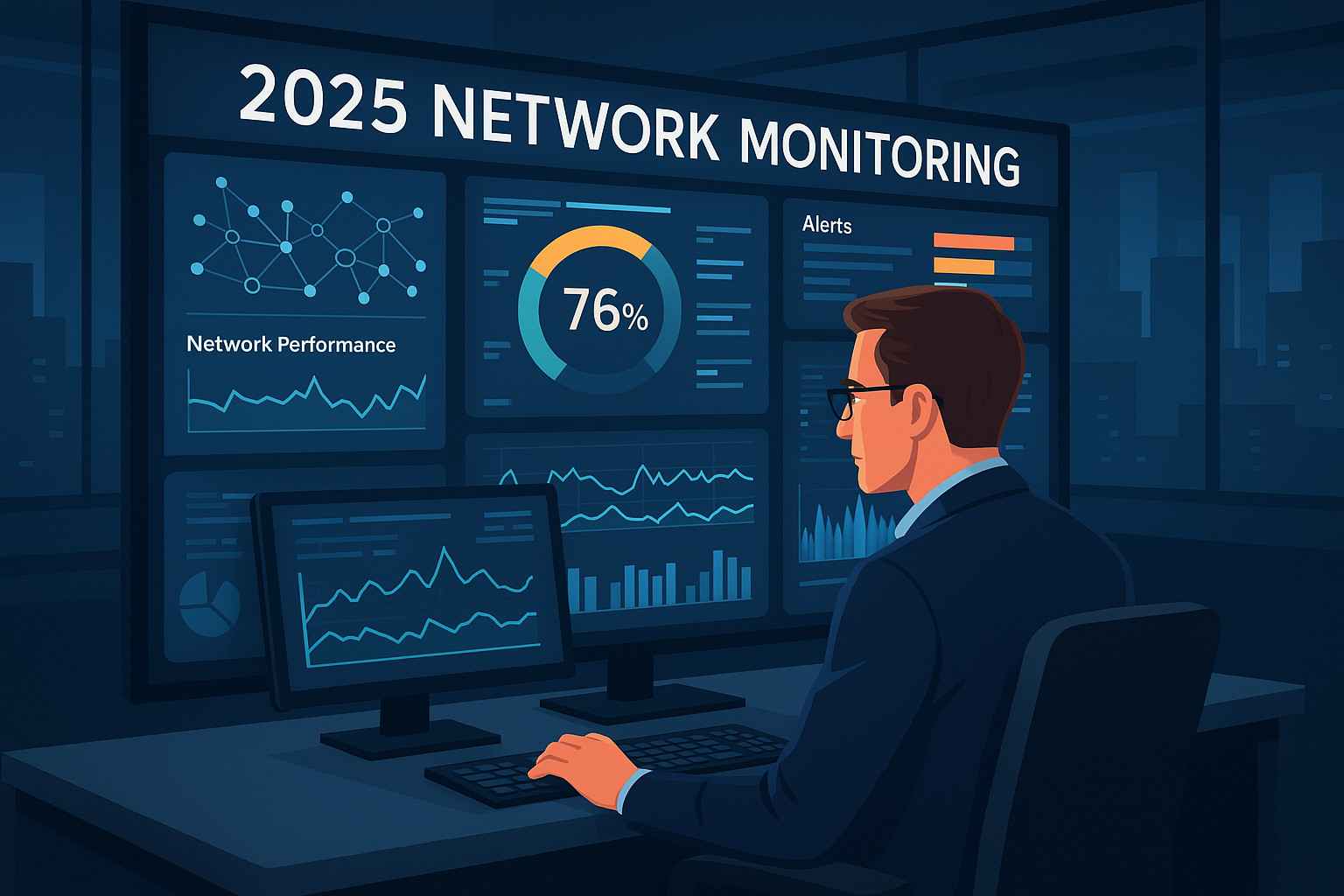Complete Guide: Why You Must Deploy a Network Monitoring System in 2025
[Joli-toc]
Introduction
In the fast-evolving digital era, business continuity hinges on how well your IT infrastructure performs. From supporting hybrid workforces to ensuring 24/7 cloud operations, network performance directly influences productivity, revenue, and user experience.
This is where network monitoring systems step in—providing visibility, control, and predictive analytics across your entire network ecosystem. In this guide, we’ll break down the ins and outs of network monitoring, including infrastructure components, business benefits, and why these tools are a strategic must-have in 2025.
What is Network Infrastructure?
A network infrastructure is the foundation of any digital business operation. It consists of all interconnected components that manage, route, and secure data traffic between users, devices, and services. Key components include:
- Routers: Direct internet traffic and enable external connectivity
- Switches: Connect internal devices like computers and printers
- Wi-Fi Access Points: Enable wireless connections for mobile and IoT devices
- Firewalls: Filter traffic to block malicious access attempts
- Servers: Host business applications, data, and services
- Cables, hubs, load balancers, and cloud connectors
Each element must perform optimally to support business operations, and that’s why real-time network monitoring is critical.
What is Network Monitoring?
Network monitoring refers to the continuous collection, analysis, and reporting of data from network components to:
- Detect performance bottlenecks
- Identify security threats
- Predict system failures
- Optimize bandwidth and resource allocation
- Ensure maximum uptime
In 2025, network monitoring goes beyond traditional tools by leveraging AI and machine learning for predictive alerts, automated remediation, and intelligent recommendations.
Why Network Monitoring is Essential in 2025
Here’s a deep dive into the core benefits and strategic value of deploying network monitoring tools in today’s IT landscape:
1. Centralized Network Visibility
Modern businesses operate on complex, hybrid networks with physical, cloud, and remote elements. Without a unified view, IT teams struggle to detect and fix problems quickly.
How it helps:
- Monitor all devices—routers, switches, servers, cloud platforms—from a single dashboard
- View real-time health metrics across geographies
- Identify slowdowns, device failures, or bandwidth congestion instantly
No more logging into multiple systems or relying on guesswork.
2. Downtime Reduction and Fast Recovery
Downtime is expensive. According to industry reports, even one minute of network downtime can cost thousands in lost revenue and productivity.
With monitoring tools:
- Receive instant alerts when performance deviates from the baseline
- Use automated root cause analysis to speed up resolution
- Trigger failover processes or service restarts before customers are impacted
Reduces MTTR (Mean Time to Repair) and ensures better SLA compliance.
3. Data-Driven IT Decisions and Planning
Want to scale your business or migrate to the cloud? You need data. Network monitoring tools provide:
- Historical performance logs for trend analysis
- Predictive insights into when to upgrade bandwidth or hardware
- Usage patterns to optimize resource allocation and capacity planning
Helps justify IT budgets and prevents over/under-investment.
4. Predictive Maintenance with AI
Advanced tools in 2025 don’t just monitor—they learn from patterns and forecast potential failures.
Example:
If a server’s memory usage increases consistently over time, the system will predict a crash and alert the admin days in advance.
Benefits:
- Avoid unexpected outages
- Fix vulnerabilities before users are impacted
- Maintain high availability
5. Real-Time Threat Detection and Security Monitoring
A monitoring system isn’t just for performance—it’s also a key part of your cybersecurity strategy.
It helps identify:
- Unusual traffic spikes or connection attempts
- Data leaks or DDoS attacks in progress
- Unauthorized device access
Integrated with threat intelligence, it acts as an early warning system for your IT security.
6. Support for Remote and Hybrid Workforces
Remote work is here to stay. Monitoring tools help ensure consistent connectivity and security for your distributed workforce.
Key capabilities:
- Monitor VPN tunnels and endpoint device performance
- Identify network disruptions affecting remote teams
- Troubleshoot connectivity issues from one dashboard
Helps keep employees productive regardless of location.
7. Real-Time Troubleshooting and Automated Resolution
No more long wait times for IT to respond. Modern monitoring tools offer:
- Live diagnostics (CPU usage, disk errors, ping latency, etc.)
- Automation workflows for restarting services or rerouting traffic
- Custom alert thresholds for different severity levels
⚙️ Free up your IT staff to focus on innovation, not manual fixes.
8. Compliance, Reporting & Documentation
Compliance regulations like ISO, HIPAA, and GDPR require complete visibility and auditing capabilities.
Monitoring tools:
- Log every access point and data flow
- Provide downloadable reports for audits
- Ensure data integrity and traceability
Crucial for businesses in regulated industries like healthcare, finance, and government.
9. Improved Network Performance and User Experience
Users expect speed. Whether it’s accessing cloud apps or downloading files, performance is non-negotiable.
Monitoring helps:
- Track latency, jitter, packet loss, and throughput
- Identify underperforming devices or links
- Allocate bandwidth dynamically based on real-time needs
Better performance = happier users + fewer complaints.
10. Scalability and Future-Readiness
As your business grows, so will your infrastructure. Monitoring systems scale easily with:
- Multi-location, multi-device support
- Agent-based and agentless deployment options
- APIs for integration with other tools (ITSM, CMDB, etc.)
You can manage a 10-device network or a 10,000-device infrastructure with ease.
Bonus: How to Choose the Right Network Monitoring Tool
Look for these must-have features:
- Central dashboard
- AI-powered alerting and prediction
- Cloud, on-prem, and hybrid support
- Customizable alert thresholds
- Integration with ITSM/DevOps tools
- Mobile app for monitoring on-the-go
- Historical and real-time reporting
- Automation capabilities
Popular tools: Nagios, Zabbix, SolarWinds, PRTG, ManageEngine OpManager, Motadata, and Datadog
Final Thoughts: A Strategic Investment
In 2025, deploying a network monitoring system is no longer an IT luxury—it’s a business-critical necessity. Whether you’re running a startup or a global enterprise, these tools help you:
- Secure your network
- Avoid revenue loss
- Make smarter IT decisions
- Empower a mobile workforce
- Reduce costs through automation and optimization
Key Takeaways
Monitor every network component in real-time
Predict and prevent outages before they escalate
Strengthen your cybersecurity defenses
Gain insights to scale and optimize your IT
Improve user experience, compliance, and ROI
Related Resources:
Computer Networking for Beginners – A Step-by-Step Guide
IoT Scanner – Is Your Device Vulnerable to DoS Attacks?
Like this Article?
Subscribe to our YouTube Channel for IoT tutorials and tech explainers.










Leave a Review